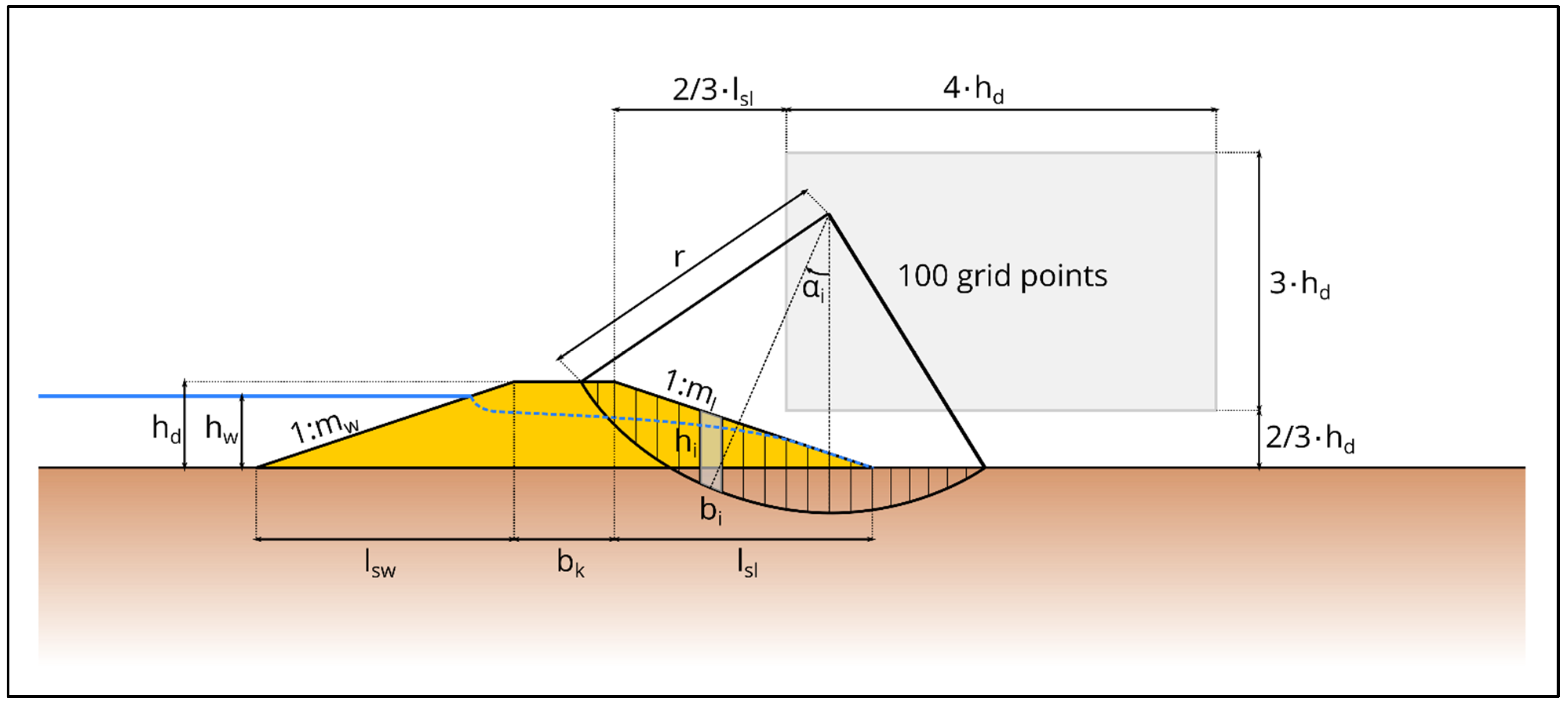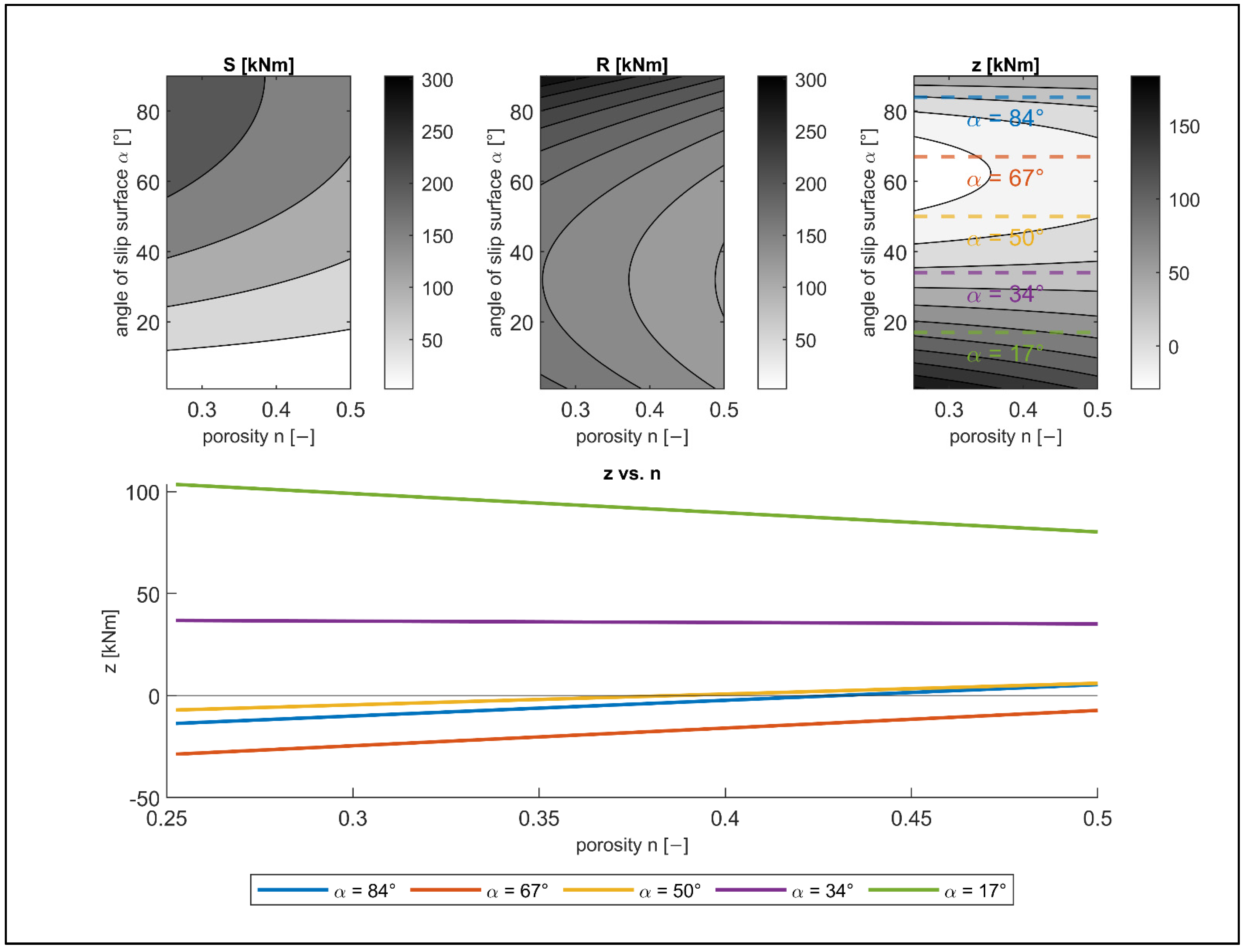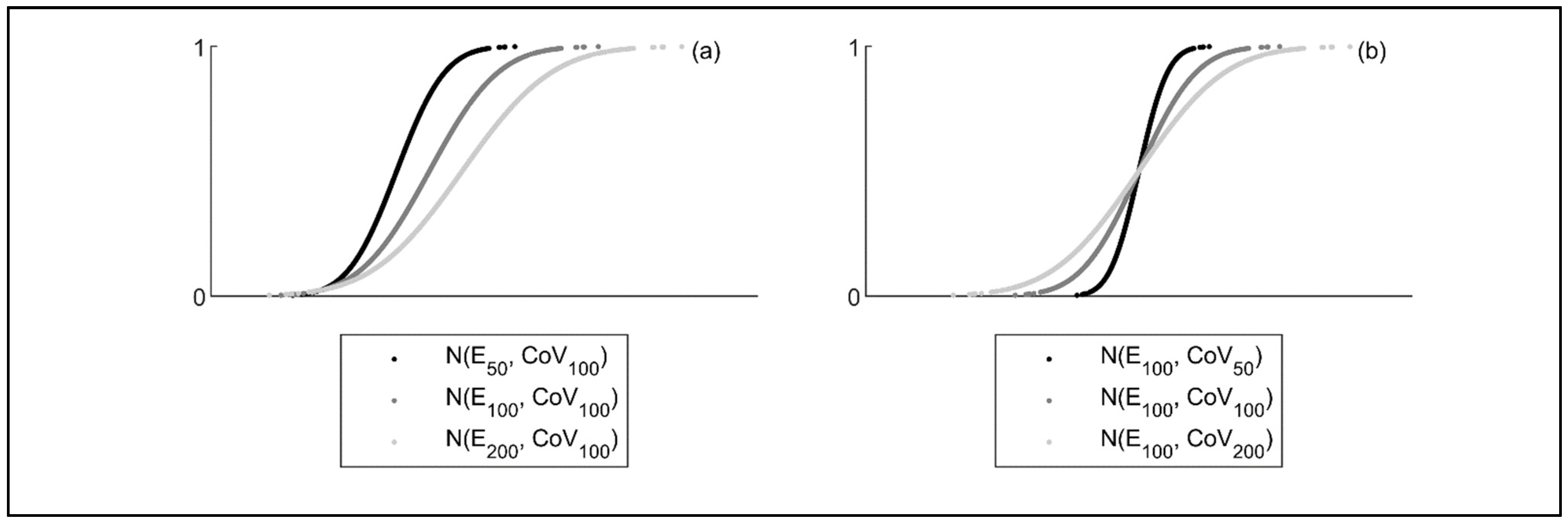Geometric and Material Variability of the Probability of Landward Slope Failure for Homogeneous River Levees
Abstract
:1. Introduction
2. Methodology
2.1. Levee Slope Stability
2.2. Probabilistic Input Parameters
2.3. Determination of Failure Probability
3. Setup of Empirical Experiment
4. Results
4.1. Variability Quantification
4.2. Influence of Porosity
5. Discussion
5.1. General
5.2. Geometric Influences
5.3. Material Influences
6. Conclusions and Outlook
- The landward slope of the levee;
- The expected value of the friction angle or porosity (e.g., by selecting a different material); or
- The coefficient of variation of the friction angle (e.g., by arranging a corresponding quality-check).
Author Contributions
Funding
Institutional Review Board Statement
Informed Consent Statement
Data Availability Statement
Acknowledgments
Conflicts of Interest
Appendix A
| Variable | Scenario | Model | Equation | Validity Interval | R2 |
|---|---|---|---|---|---|
| 1 | rational | 0.9985 | |||
| 2-1 | rational | 0.9962 | |||
| 2-2 | rational | 0.9970 | |||
| 3 | exponential | 0.9807 | |||
| 1 | rational | 0.9998 | |||
| 2-1 | rational | 0.9996 | |||
| 2-2 | rational | 0.9998 | |||
| 3 | exponential | 0.9852 | |||
| 1 | linear | 0.9855 | |||
| 2-1 | polynomial | 0.9804 | |||
| 2-2 | linear | 0.9675 | |||
| 3 | linear | 0.9879 | |||
| 1 | rational | 0.9981 | |||
| 2-1 | rational | 0.9995 | |||
| 2-2 | rational | 0.9996 | |||
| 3 | rational | 0.9992 | |||
| 1 | rational | 0.9974 | |||
| 2-1 | rational | 0.9996 | |||
| 2-2 | rational | 0.9997 | |||
| 3 | rational | 0.9995 |
References
- Tikhamarine, Y.; Souag-Gamane, D.; Ahmed, A.N.; Sammen, S.S.; Kisi, O.; Huang, Y.F.; El-Shafie, A. Rainfall-runoff modelling using improved machine learning methods: Harris hawks optimizer vs. particle swarm optimization. J. Hydrol. 2020, 589, 125133. [Google Scholar] [CrossRef]
- Wan, W.; Guo, W.; Huang, H.; Liu, J. Nonnegative and Nonlocal Sparse Tensor Factorization-Based Hyperspectral Image Super-Resolution. IEEE Trans. Geosci. Remote Sens. 2020, 58, 8384–8394. [Google Scholar] [CrossRef]
- Wang, P.; Wang, L.; Leung, H.; Zhang, G. Super-Resolution Mapping Based on Spatial–Spectral Correlation for Spectral Imagery. IEEE Trans. Geosci. Remote Sens. 2021, 59, 2256–2268. [Google Scholar] [CrossRef]
- Thieken, A.H.; Samprogna Mohor, G.; Kreibich, H.; Müller, M. Compound inland flood events: Different pathways, different impacts and different coping options. Nat. Hazards Earth Syst. Sci. 2022, 22, 165–185. [Google Scholar] [CrossRef]
- Özer, I.E.; Rikkert, S.J.H.; van Leijen, F.J.; Jonkman, S.N.; Hanssen, R.F. Sub-seasonal Levee Deformation Observed Using Satellite Radar Interferometry to Enhance Flood Protection. Sci. Rep. 2019, 9, 2646. [Google Scholar] [CrossRef] [PubMed] [Green Version]
- Kool, J.; Kanning, W.; Heyer, T.; Jommi, C.; Jonkman, S.N. Forensic Analysis of Levee Failures: The Breitenhagen Case. Int. J. Geoengin. Case Hist. 2019, 5, 71–92. [Google Scholar]
- Kool, J.J.; Kanning, W.; Jommi, C.; Jonkman, S.N. A Bayesian hindcasting method of levee failures applied to the Breitenhagen slope failure. Georisk Assess. Manag. Risk Eng. Syst. Geohazards 2020, 15, 299–316. [Google Scholar] [CrossRef]
- Khairul, I.M.; Rasmy, M.; Ohara, M.; Takeuchi, K. Developing Flood Vulnerability Functions through Questionnaire Survey for Flood Risk Assessments in the Meghna Basin, Bangladesh. Water 2022, 14, 369. [Google Scholar] [CrossRef]
- Blanco-Vogt, A.; Schanze, J. Assessment of the physical flood susceptibility of buildings on a large scale—Conceptual and methodological frameworks. Nat. Hazards Earth Syst. Sci. 2014, 14, 2105–2117. [Google Scholar] [CrossRef] [Green Version]
- Merz, B. Hochwasserrisiken: Grenzen und Möglichkeiten der Risikoabschätzung: Mit 33 Tabellen; Schweizerbart: Stuttgart, Germany, 2006; ISBN 3510652207. [Google Scholar]
- CIRIA. The International Levee Handbook; CIRIA: London, UK, 2013; ISBN 978-0-86017-734-0. [Google Scholar]
- ENW. Fundamentals of Flood Protection, December 2016-English edition April 2017; Ministry of Infrastructure and the Environment and the Expertise Network for Flood Protection (ENW): Breda, The Netherlands, 2017; ISBN 9789089021601.
- Kortenhaus, A. Probabilistische Methoden für Nordseedeiche. Ph.D. Thesis, Technische Universität Carolo-Wilhelmina zu Braunschweig, Braunschweig, Germany, 2003. [Google Scholar]
- Heyer, T. Zuverlässigkeitsbewertung von Flussdeichen nach dem Verfahren der Logistischen Regression. Ph.D. Thesis, Technische Universität Dresden, Dresden, Germany, 2011. ISBN 9783867801973. [Google Scholar]
- Özer, I.E.; van Damme, M.; Jonkman, S.N. Towards an International Levee Performance Database (ILPD) and Its Use for Macro-Scale Analysis of Levee Breaches and Failures. Water 2020, 12, 119. [Google Scholar] [CrossRef] [Green Version]
- Müller, U. Hochwasserrisikomanagement: Theorie und Praxis; Vieweg + Teubner: Wiesbaden, Germany, 2010; ISBN 9783834812476. [Google Scholar]
- Bachmann, D. Beitrag zur Entwicklung Eines Entscheidungsunterstützungssystems zur Bewertung und Planung von Hochwasserschutzmaßnahmen. Ph.D. Thesis, RWTH Aachen University, Aachen, Germany, 2012. [Google Scholar]
- DWA Deutsche Vereinigung für Wasserwirtschaft, Abwasser und Abfall. Merkblatt DWA-M 507-1: Deiche an Fließgewässern. Teil 1: Planung, Bau und Betrieb, Dezember 2011; Deutsche Vereinigung für Wasserwirtschaft Abwasser und Abfall: Hennef, Germany, 2011; ISBN 978-3-941897-76-2. [Google Scholar]
- Merz, B.; Bittner, R. Management von Hochwasserrisiken: Mit Beiträgen aus den RIMAX-Forschungsprojekten; Förderaktivität Risikomanagement Extremer Hochwasserereignisse; Schweizerbart: Stuttgart, Germany, 2011; ISBN 9783510652686. [Google Scholar]
- Federal Ministry for the Environment. Nature Conservation and Nuclear Safety; National Water Strategy: Berlin, Germany, 2021.
- Patt, H.; Jüpner, R. Hochwasser-Handbuch: Auswirkungen und Schutz; Springer: Wiesbaden, Germany, 2020; ISBN 9783658267421. [Google Scholar]
- Tümmers, H.-J. Der Rhein: Ein europäischer Fluß und seine Geschichte; Beck: München, Germany, 1999; ISBN 3406448232. [Google Scholar]
- Die Elbe—Wasserstraße und Auenlandschaft: Vorträge zum Wasserbaukolloquium am 14.10.1993; Lattermann, E. (Ed.) Selbstverlag der Technischen Universität Dresden: Dresden, Germany, 1994. [Google Scholar]
- ILPD. Available online: https://leveefailures.tudelft.nl/ (accessed on 16 September 2021).
- Kool, J.J.; Kanning, W.; Jonkman, S.N. The influence of deviating conditions on levee failure rates. J. Flood Risk Manag. 2022, in press. [Google Scholar] [CrossRef]
- Di Matteo, L.; Valigi, D.; Ricco, R.; Romeo, S. Effect of Laboratory Repeatability of Direct Shear Test on Slope Stability. In Geotechnical Safety and Risk V.; Schweckendiek, T., Ed.; IOS Press: Amsterdam, The Netherlands, 2015; pp. 808–812. ISBN 9781614995791. [Google Scholar]
- Griffiths, D.V.; Huang, J.; Fenton, G.A. Probabilistic Slope Stability Analysis using RFEM with Non-Stationary Random Fields. In Geotechnical Safety and Risk V.; Schweckendiek, T., Ed.; IOS Press: Amsterdam, The Netherlands, 2015; pp. 704–709. ISBN 9781614995791. [Google Scholar]
- Wewer, M.; Aguilar-López, J.P.; Kok, M.; Bogaard, T. A transient backward erosion piping model based on laminar flow transport equations. Comput. Geotech. 2021, 132, 103992. [Google Scholar] [CrossRef]
- Weißmann, R. Probabilistische Bewertung der Zuverlässigkeit von Flussdeichen unter Hydraulischen und Geotechnischen Gesichtspunkten. Ph.D. Thesis, Karlsruher Institut für Technologie, Karlsruhe, Germany, 2014. [Google Scholar]
- Lendering, K.; Schweckendiek, T.; Kok, M. Quantifying the failure probability of a canal levee. Georisk Assess. Manag. Risk Eng. Syst. Geohazards 2018, 12, 203–217. [Google Scholar] [CrossRef]
- Türke, H. Statik im Erdbau, 3rd ed.; John Wiley & Sons: Hoboken, NJ, USA, 1999; ISBN 3-433-01791-3. [Google Scholar]
- Kolymbas, D. Geotechnik: Bodenmechanik, Grundbau und Tunnelbau; Springer: Berlin, Germany, 2016; ISBN 978-3-662-53592-9. [Google Scholar]
- Lang, H.-J.; Huder, J.; Amann, P.; Puzrin, A.M. Bodenmechanik und Grundbau—Das Verhalten von Böden und Fels und Die Wichtigsten Grundbaulichen Konzepte; Springer: Berlin/Heidelberg, Germany, 2011; ISBN 978-3-642-14686-2. [Google Scholar]
- DIN Deutsches Institut für Normung e. V. E DIN 4084 Baugrund: Geländebruchberechnung; Beuth Verlag GmbH: Berlin, Germany; Wien, Austria; Zürich, Switzerland, 2021. [Google Scholar]
- Baecher, G.B.; Christian, J.T. Reliability and Statistics in Geotechnical Engineering; Wiley: Chichester, UK, 2003; ISBN 9780471498339. [Google Scholar]
- Ang, A.H.-S.; Tang, W.H. Probability Concepts in Engineering Planning and Design, 2nd ed.; John Wiley & Sons: Hoboken, NJ, USA; Chichester, UK, 2006; ISBN 9780471720645. [Google Scholar]
- ISSMGE-TC304. 304dB TC304 Databases. Available online: http://140.112.12.21/issmge/tc304.htm (accessed on 27 January 2022).
- Schwiersch, N.; Heyer, T.; Stamm, J. Enriching flood risk analyses with distributions of soil mechanical parameters through the statistical analysis of classification experiments. J. Flood Risk Manag. 2022, in press. [Google Scholar] [CrossRef]
- Bautabellen für Ingenieure: Mit Berechnungshinweisen und Beispielen; Albert, A. (Ed.) Bundesanzeiger Verl.: Köln, Germany, 2014; ISBN 978-3-8462-0304-0. [Google Scholar]
- Arbeitsausschuss Ufereinfassungen; Deutsche Gesellschaft für Geotechnik; Wilhelm Ernst & Sohn. Empfehlungen des Arbeitsausschusses “Ufereinfassungen”: Häfen und Wasserstrassen EAU 2012; 11. vollständig überarbeitete Auflage; Ernst & Sohn: Berlin, Germany, 2012; ISBN 978-3-433-01848-4. [Google Scholar]
- Lee, I.K.; White, W.; Ingles, O.G. Geotechnical Engineering; Pitman: Boston, MA, USA, 1983. [Google Scholar]
- Lacasse, S.; Nadim, F. Uncertainties in characterizing soil properties. Uncertain. Geol. Environ. 1996, 49–75. [Google Scholar]
- Lumb, P. Application of statistics in soil mechanics. In Soil Mechanics: New Horizons; Newnes-Butterworth: London, UK, 1974; pp. 221–239. [Google Scholar]
- Stichting Civieltechnisch Centrum Uitvoering Research en Regelgeving; Technische Adviescommissie voor de Waterkeringen. Probabilistic Design of Flood Defences; CUR: Gouda, The Netherlands, 1990; ISBN 90-376-0009-3. [Google Scholar]
- Simmer, K. Grundbau; Teubner: Stuttgart, Germany, 1980; ISBN 3-519-25231-7. [Google Scholar]
- Magnan, J.-P. Cours de Méchanique des Sols et des Roches. Skriputm; Ecole Nationale des Points et Chaussees: Paris, France, 2000. [Google Scholar]
- Schmalz, B. Grundwasser Modul 269: Grundwasserströmung; Universität Kiel: Kiel, Germany, 2011. [Google Scholar]
- Koch, M. Skript Ingenieurhydrologie I. Skriptum; Universität Kassel: Kassel, Germany, 2003. [Google Scholar]
- Phoon, K.-K.; Kulkhawy, F.H. Characterization of Geotechnical Variability. Can. Geotech. J. 1999, 36, 612–624. [Google Scholar] [CrossRef]
- Bachmann, D. ProMaIDes Documentation. Available online: https://promaides.myjetbrains.com/youtrack/articles/PMID-A-7/General (accessed on 22 October 2021).
- Bachmann, D.; Schneppe, F.; Jenning, S.; Huber, N.P.; Schüttrumpf, H. Zuverlässigkeitsbezogene Analyse der Emscherdeiche zur Erweiterung des D³-HOWIS-Systems: Emscher, Fluss-km 0,0 bis 19,7. Hauptbericht; RWTH Aachen: Aachen, Germany, 2011. [Google Scholar]
- Kempfert, H.-G.; Raithel, M. Bodenmechanik und Grundbau; Bauwerk: Berlin, Germany, 2007; ISBN 9783899321487. [Google Scholar]
- Schneider, J.; Schlatter, H.P. Sicherheit und Zuverlässigkeit im Bauwesen: Grundwissen für Ingenieure; Teubner, B.G., Ed.; vdf Hochschulverlag AG an der ETH: Stuttgart, Germany; Zürich, Switzerland, 1996; ISBN 3728121673. [Google Scholar]
- DWA Deutsche Vereinigung für Wasserwirtschaft, Abwasser und Abfall. In Merkblatt DWA-M 520—Probabilistische Methoden im Wasserbau: Entwurf; Deutsche Vereinigung für Wasserwirtschaft Abwasser und Abfall: Hennef (Sieg), Germany, 2022; unpublished.
- Möllmann, A.F.D. Probabilistische Untersuchung von Hochwasserschutzdeichen mit analytischen Verfahren und der Finite-Elemente-Methode. Ph.D. Thesis, Universität Stuttgart, Stuttgart, Germany, 2009. [Google Scholar]
- Huber, N.P. Probabilistische Modellierung von Versagensprozessen bei Staudämmen. Ph.D. Thesis, RWTH Aachen, 2008; Shaker: Aachen, Germany, 2011; ISBN 9783844004014. [Google Scholar]
- Wang, Y.; Cao, Z.; Au, S.-K. Practical reliability analysis of slope stability by advanced Monte Carlo simulations in a spreadsheet. Can. Geotech. J. 2011, 48, 162–172. [Google Scholar] [CrossRef]
- Griffiths, D.V.; Fenton, G.A. Probabilistic Slope Stability Analysis by Finite Elements. J. Geotech. Geoenviron. Eng. 2004, 130, 507–518. [Google Scholar] [CrossRef] [Green Version]
- Ho, I.-H. Parametric Studies of Slope Stability Analyses Using Three-Dimensional Finite Element Technique: Geometric Effect. J. GeoEngineering 2014, 9, 33–43. [Google Scholar]
- Bachmann, D.; Huber, N.P.; Johann, G.; Schüttrumpf, H. Fragility curves in operational dike reliability assessment. Georisk Assess. Manag. Risk Eng. Syst. Geohazards 2013, 7, 49–60. [Google Scholar] [CrossRef]
- López Acosta, N.P.; Carillo Tutivén, J.R.; Barba Galdámez, D.F.; Jaimes Téllez, M.Á.; Zwanenburg, C. Obtaining fragility curves on levees subjected to flooding. In Geotechnical Engineering—Foundation of the Future: Proceedings of the XVII European Conference on Soil Mechanics and Geotechnical Engineering, Reykjavik; Sigursteinsson, H., Ed.; The Icelandic Geotechnical Society, IGS: Reykjavik, Iceland, 2019; ISBN 9789935943613. [Google Scholar]
- Abtahi, M. General and Stability Analysis of Levee Failures by Means of Probabilistic Approaches. Ph.D. Thesis, Technische Universität Dresden, Dresden, Germany, 2018. [Google Scholar]
- Jacob, G. Recherche und Beurteilung der Unterschiedlichen Bauweisen von Flussdeichen Entlang der Deutschen Elbe. Bachelor‘s Thesis, Technische Universität Dresden, Dresden, Germany, 2019. [Google Scholar]
- Haselsteiner, R. Hochwasserschutzdeiche an Fließgewässern und ihre Durchsickerung. Ph.D. Thesis, Technische Universität München, München, Germany, 2007. [Google Scholar]
- Schwiersch, N.; Dumke, B.; Stamm, J. Probabilistic determination of the phreatic line in river levees under steady-state conditions and its effect on the stability statement. In Proceedings of the 31st European Safety and Reliability Conference, Angers, France, 19–23 September 2021; Castanier, B., Cepin, M., Bigaud, D., Berenguer, C., Eds.; Research Publishing Singapore: Singapore, 2021; pp. 1777–1782, ISBN 978-981-18-2016-8. [Google Scholar]






| Soil Types | |||||||||
|---|---|---|---|---|---|---|---|---|---|
| Distribution | E [°] | COV [−] | Distribution | E [kN/m²] | COV [−] | Distribution | E [−] | COV [−] | |
| GE | Normal | 36.4 | 0:1 | Lognormal | 0 | 0.3 | Normal | 0.30 | 0.2 |
| GW, GI | 36.9 | 0 | |||||||
| GU, GT | 38 | 3.5 | |||||||
| GU*, GT* | 35.5 | 10 | |||||||
| SE | 35.3 | 0 | 0.40 | ||||||
| SW, SI | 35.5 | 0 | |||||||
| SU, ST | 34.5 | 3 | |||||||
| SU*, ST* | 32 | 9.3 | |||||||
| UL | 30.1 | 0.3 | 5.6 | 0.50 | |||||
| UM, UA | 27.9 | 8.4 | |||||||
| TL | 26.9 | 15.6 | |||||||
| TM | 24.3 | 20 | |||||||
| TA | 21.6 | 23.1 | |||||||
| Nr. | Variable Xi | Unit | ||||
|---|---|---|---|---|---|---|
| Lower | Upper | Lower | Upper | |||
| 1 | m | 4.00 | 6.0 | 0.8 | 1.7 | |
| 2 | m | 0.10 | 8.0 | 0.8 | 1.2 | |
| 3 | - | 1.50 | 5 | 0.8 | 1.2 | |
| 4 | - | 1.50 | 5 | 0.8 | 1.2 | |
| 5 | ° | 24.2 | 44.9 | 0.7 | 1.3 | |
| 6 | kN/m² | 2.1 | 5.1 | 0.7 | 1.3 | |
| 7 | - | 0.3 | 0.5 | 0.7 | 1.3 | |
| 8 | % | 3.0 | 50.0 | 0.3 | 5.0 | |
| 9 | % | 9.0 | 150.0 | 0.3 | 5.0 | |
| 10 | % | 6.0 | 100.0 | 0.3 | 5.0 | |
| Scenario | Cohesion | |
|---|---|---|
| Levee | Subsoil | |
| 1 | No | No |
| 2-1 | Yes | No |
| 2-2 | No | Yes |
| 3 | Yes | Yes |
Publisher’s Note: MDPI stays neutral with regard to jurisdictional claims in published maps and institutional affiliations. |
© 2022 by the authors. Licensee MDPI, Basel, Switzerland. This article is an open access article distributed under the terms and conditions of the Creative Commons Attribution (CC BY) license (https://creativecommons.org/licenses/by/4.0/).
Share and Cite
Schwiersch, N.; Stamm, J. Geometric and Material Variability of the Probability of Landward Slope Failure for Homogeneous River Levees. Sustainability 2022, 14, 2833. https://doi.org/10.3390/su14052833
Schwiersch N, Stamm J. Geometric and Material Variability of the Probability of Landward Slope Failure for Homogeneous River Levees. Sustainability. 2022; 14(5):2833. https://doi.org/10.3390/su14052833
Chicago/Turabian StyleSchwiersch, Niklas, and Jürgen Stamm. 2022. "Geometric and Material Variability of the Probability of Landward Slope Failure for Homogeneous River Levees" Sustainability 14, no. 5: 2833. https://doi.org/10.3390/su14052833
APA StyleSchwiersch, N., & Stamm, J. (2022). Geometric and Material Variability of the Probability of Landward Slope Failure for Homogeneous River Levees. Sustainability, 14(5), 2833. https://doi.org/10.3390/su14052833






